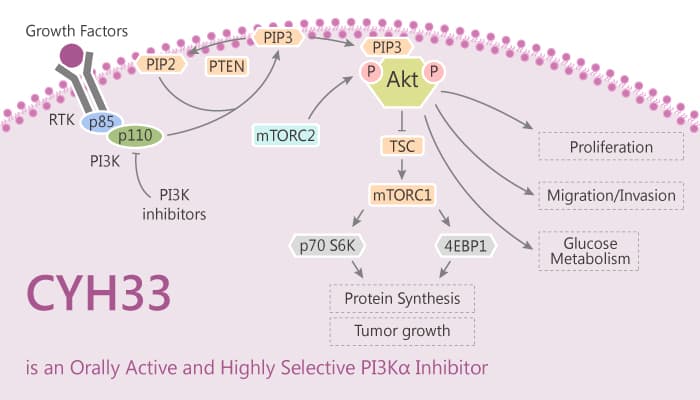PI3Ks are a class of enzymes involved in cell function, such as cell growth, proliferation, differentiation, movement, survival, and intracellular transport. And these cells are relevant to cancer. Specifically, I3K is a kind of related intracellular signal transduction enzymes, which can phosphorylate the 3-hydroxy group of phosphatidylinositol (PtdIns). In breast cancer, the abnormal activation of PI3K α often occurs through other mechanisms, including over activation of upstream receptor tyrosine kinase (RTK), ras mutation, and so on. Besides, the current resistance to endocrine therapy and chemotherapy for breast cancer is partly due to the activation of the PI3K/Akt/mTOR pathway. Besides, selective targeting of PI3K α has been proved to be a promising treatment for cancer. And it can improve the therapeutic effect and avoid the side effects associated with other subtypes of PI3K family. CYH33 is an orally active, highly selective PI3Kα inhibitor.

CYH33 is an orally active, highly selective PI3Kα inhibitor with potent activity against solid tumors.
But, how does CYH33 protect against cancer cells via PI3Kα? Let’s discuss it in detail. In the beginning, YH33 is an orally active, highly selective PI3Kα inhibitor with IC50s of 5.9 nM/598 nM/78.7 nM/225 nM against α/β/δ/γ isoform, respectively. Furthermore, CYH33 inhibits phosphorylation of Akt, ERK. And it induces significant G1 phase arrest in breast cancer cells and non-small cell lung cancer (NSCLC) cells. Meanwhile, CYH33 has potent activity against solid tumors.
In the second place, CYH33 inhibits cell proliferation with IC50s below 1 μM in 56% (18/32) of the breast cancer cell lines. Nonetheless, CYH33 significantly arrests T47D and MCF7 cells in G1 phase in a concentration-dependent manner. Importantly, CYH33 concurrently inhibits phosphorylation of ERK and Akt in both T47D and MCF7 cells. Particularly, CYH33 fails to induce apoptosis in MCF7 and MDA-MB-231 cells.
Last but not the least, CYH33 potently restrains tumor growth in mice bearing human breast cancer cell xenografts. Single administration of CYH33 significantly down-regulates the level of phosphorylated Akt in tumor tissues, demonstrating the suppression of PI3K signaling in nude mice. Obviously, CYH33 delays the restoration of blood glucose and area under the curve (AUC) of blood glucose increased upon CYH33 treatment in T47D xenografts and R26-Pik3caH1047R;MMTV-Cre mice.
All in all, CYH33 is an orally active, highly selective PI3Kα inhibitor with potent activity against solid tumors.
References:
Xue-Ling Liu, et al. Cancer Lett. 2018 Oct 1;433:273-282.